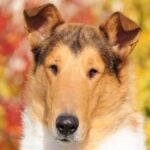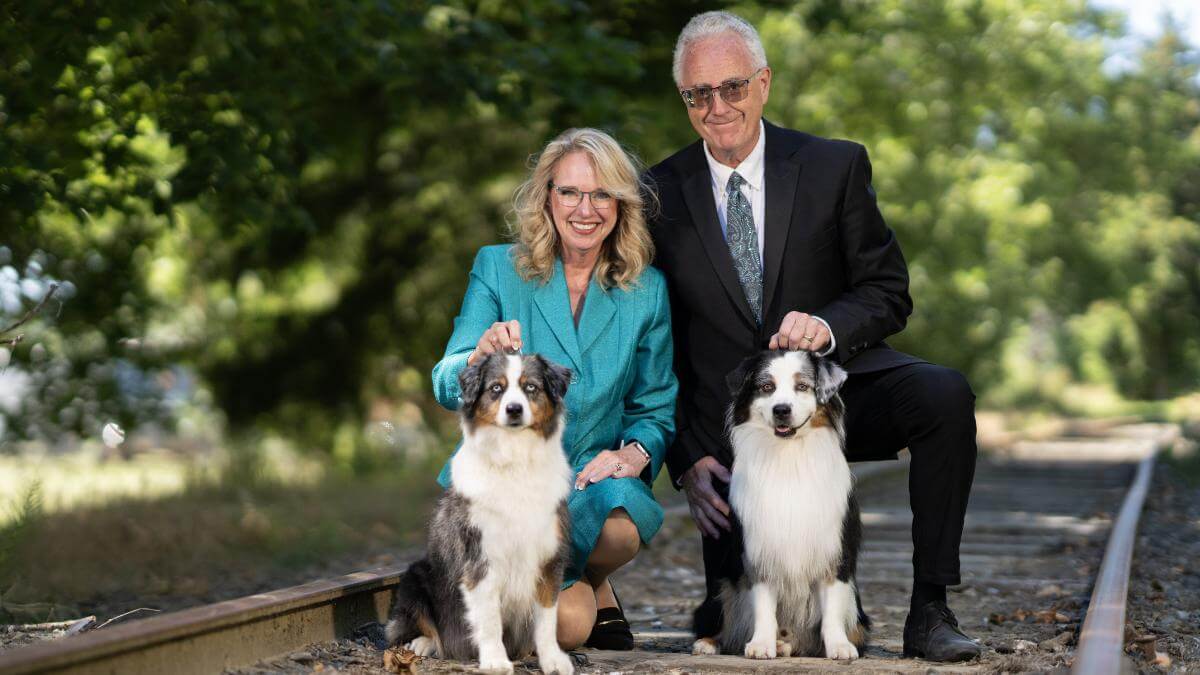
Home » Melisa & Mark Tiffany | Tiffany Heights Miniature American Shepherds

Melisa & Mark Tiffany
1. We are Mark and Melisa Tiffany, and we live in Spokane, Washington, which is on the far east side of Washington State close to Idaho. I (Melisa) started in dogs in 4-H and Junior Showmanship as a kid, but I drifted away from it with college and work, four kids, and life. I didn’t really plan on coming back to it, but I got a Miniature American Shepherd puppy that I fell in love with and I promised her breeder she could show and breed her. The first weekend out, she encouraged me to go ahead and take her in the ring; we got a five-point major from the the 6-9 Month Puppy Bitch class and I was hooked. That was eight and a half years ago and her name is “Jemma,” GCHP Chandreas Tiffany Blue CD BN RM2 RAE PT FDC NA NAJ OAP NF FCAT CGCA CGCU TKI ATT. I could write an entire article about her accomplishments, and all the “firsts” and “onlys” that she has claimed in our breed, and the adventures we have had in the NOHS (National Owner-Handled Series) world. Her first litter was almost six years ago and that is the litter that gave us “Rock.” She now has multiple Champions all the way up to GCHG and several BISS winners, plus more with many Performance titles, including Herding.
I have six years as a breeder, and our kennel is Tiffany Heights. I have worked with incredible mentors, the primary ones being Jemma’s breeders, Cheryl and Andrea Hass of Chandrea Farms. Cheryl was instrumental in helping me understand pedigrees and breed type, which led to us picking “Ero,” GCHG Picasso’s Habanero Heat’N Up Ultra Quest RN FDC BCAT CGC TKN ATT, as our first stud. I am also enormously grateful for other mentors and professional handlers who’ve coached and encouraged me to be better. I’m also humbled and grateful to the judges who have encouraged and instructed me, and who found my dogs in spite of my “less-than” handling skills, which have certainly come a long way in the last eight years. Jemma has been awarded “Best Brood Bitch” at five of the last six National Specialties, and Tiffany Heights has won “Breeders Showcase” for five of the last six years at our National.
I’m humbled almost daily by the people who have chosen to get a puppy from us. Their love for their dogs is a blessing and a reminder that breeding for temperament should always come first. Because so many of my owners do a variety of sports, it is also crucial to breed for structure so that those dogs will not break down during their Performance career. An upright shoulder may make for some flashy “reach,” but it won’t hold up in Agility for 10 years, and that big, sexy “turn of stifle” that doesn’t match the front assembly won’t hold up going for an Obedience Grand Master title or a Herding Trial Championship over the course of their lifetime.
Cute story alert: My husband, Mark, didn’t “grow up in dogs” and was very insistent that he would never be in the show ring, but he was happy to come along and drive the motor home. I was keeping a bitch out of that first litter, but when Mark fell in love with Rock, I said the only way we were keeping an intact male was if he was going to put on a suit and train, groom, and show HIS dog! I about fainted when he said, “Okay.” While we both handle all our dogs (except Jemma), he really has been the primary handler, piloting Rock to where he is now. He is also getting to where he isn’t half-bad at grooming!
2. First, Miniature American Shepherds should look like an Aussie (Australian Shepherd). The Breed Standards are nearly identical, except ours has height disqualifications (DQs). Judge Channing Sheets recently called the wicket with Rock, and I was thrilled! I’m so irritated (read furious) with judges who “think” a dog is oversized, and withhold awarding them, without actually measuring! The Standard is very clear that as long as the dog is in the correct range, then you must pick the most typey and sound.
Another hallmark is that they may be reserved with strangers; however, this doesn’t mean that they must be reserved with strangers. They are very connected to their person or persons, but they should never have a fearfulness or timidity about them.
I think another fun hallmark is the merle coat pattern, the multitude of ways that it is expressed and that it is all acceptable. Look at Rock and his minimal merle! The eye color also has no limitations; they can even be marbled or amber-colored.
I don’t know if it’s a hallmark of the breed or not, but I would argue that their versatility is. Jemma is titled in Conformation, Obedience, Rally, Agility, Herding, Fast CAT, and more, as are her kids and grandkids.
3. Yes, this is a wildly popular breed. So much so that backyard breeders are giving the breed a bad name by breeding dozens of litters with foul, nasty temperaments and getting away with charging exorbitant sums of money based on coat and eye color.
4. The use of DNA testing is such a tremendous asset to preventing pain and heartache for puppy owners in that dog’s future. And in a breed that has merle, being able to identify the merle sine length, and identify safer breeding stock, is a tremendous importance.
Communication? I’ve finally been nudged into developing a website, but social media (such as Facebook) is really the most powerful communication tool in my age bracket.
5. I believe so. I think, as we advocate that “adopting IS shopping” and give people permission to NOT feel guilty for wanting a well-bred and emotionally stable dog that will be a joy to live with, that people have slowly begun to turn the corner. I also think that making the business of foreign rescue imports very public, and the pitfalls from that, really helps people to stop and think about how they’re getting manipulated. I also encourage people to do their homework on “doodles” and, if they want one, to find someone who is doing all the health testing and be fully aware of the money they’ll be spending in grooming fees. Then I encourage them to look at better alternatives that are purebreds.
6. You know, back in the late 1970s, people used to fuss and complain about how political the sport was, and how it was worse than it had ever been before. So, coming back to it after 35 years, I just have to grin because the more things change, the more they stay the same.
A trend that I’m actually very concerned about is the painfully low entries in Novice A Obedience (or perhaps now Beginner Novice A). You could also include Rally Novice A in the list. I would argue that a club is only as healthy as these entries. These classes are the ones that people enter when they get a new puppy and are encouraged to train enough to compete in a beginning Obedience class. Frequently, it is with a mutt or a “moderate” purebred. This is their first introduction to dog shows, and then they begin to see the potential of what else could be out there—a fabulous, beautiful dog, and maybe a first Conformation dog? But also, along with this, is what I have seen in the attitudes of the old guard around those beginner Obedience rings. We must make sure that we are welcoming and encouraging, and that we are tolerant of mistakes.
7. I think that some of the newer sports are a fabulous way to keep people engaged and doing fun things with their dogs. I don’t think that we, as purebred preservationists, do a very good job explaining to the public that although Conformation requires your dog to be a purebred, other dog sports do not. Once somebody gets started in Companion and Performance events, it is more of a natural progression to continue to involve them, and encourage and support them as they get involved with their first well-bred purebred.